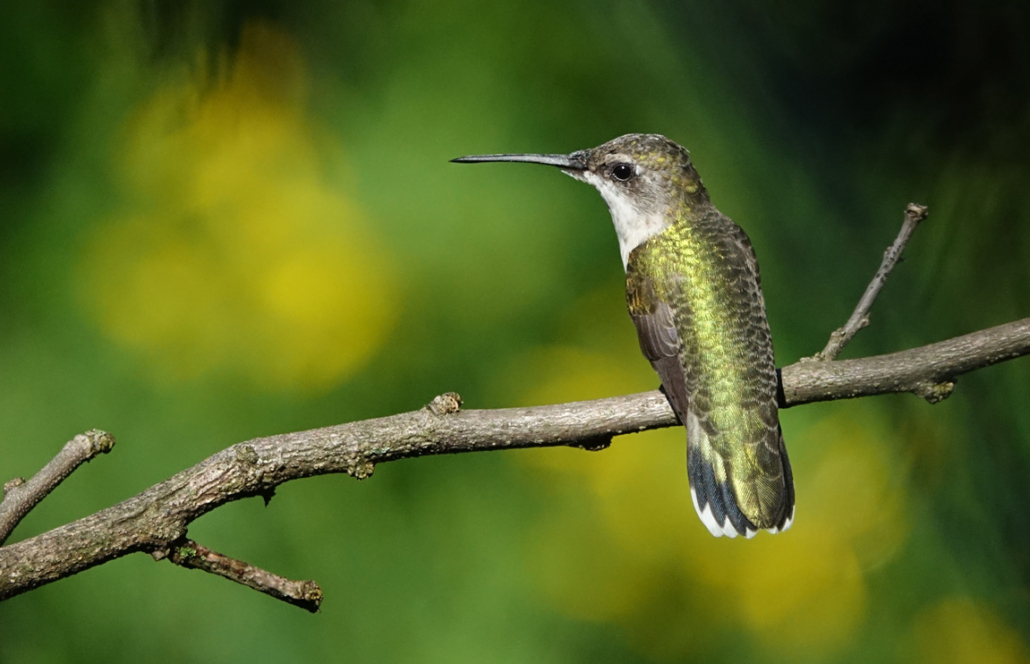SCORES & OUTDOORS: Hummingbirds vs. bees; why the hummers want no part of them

 by Roland D. Hallee
by Roland D. Hallee
My wife has a strong liking for hummingbirds. At camp, she has five feeders spread around the lot. We watch them constantly.
Lately – I’ve counted at least eight – they have been swarming the feeders, fighting amongs themselves, and it’s a wonder they get to eat at all, what with chasing any other hummer that approaches a feeding station.
Add to that the presents of bees, who during this dry spell, have been in search of liquids themselves.
Those tiny bees, keep chasing off the hummingbirds. Why would a diminutive bee scare away a hummingbird, which even though tiny themselves, are behemoths compared to the bees?
Hummingbirds belong to an avian family and their closest relatives are the equally fascinating swifts. Hummingbirds are small with long, narrow bills and small, saber-like wings.
Males (and occasionally females) often have a colorful gorget – small, stiff, highly reflective, colored feathers on the throat and upper chest. These shiny feathers and others around the head may look sooty black until a hummingbird turns its head to catch the sun and display the intense, metallic spectral color.
It makes sense that the smallest birds come from the smallest eggs, but how small? The one to two eggs in a ruby-throated hummingbird clutch are about as tiny as peas and are placed in a walnut shell-sized cup woven from spider webs and plant material.
Hummingbirds and swifts are able to stroke with power both on the down- and up-beat of a wing flap. Their power and small size allow tremendous agility in flight. In fact, hummingbirds are the only vertebrates capable of sustained hovering (staying in one place during flight), and they can fly backward and upside-down as well.
To their maneuverability, hummingbirds add speed and stamina. They have been clocked at close to 30 mph indirect flight and more than 45 mph during courtship dives. Migratory ruby-throated hummingbirds have no problem flying 18 to 20 straight hours to cross the Gulf of Mexico, powered by their fat stores and given a bit of help from winds.
A ruby-throated hummingbird’s heart beats from 225 times per minute when the bird is at rest to more than 1,200 times per minute when it is flying. Its wings beat about 70 times per second in direct flight and more than 200 times per second while diving.
Hummingbirds are one of the few groups of birds that are known to go into torpor. Torpor is a very deep, sleep-like state in which metabolic functions are slowed to a minimum and a very low body temperature is maintained. If torpor lasted for long periods, we would call it hibernation, but hummingbirds can go into torpor any night of the year when temperature and food conditions demand it.
Their high-energy lifestyle compels hummingbirds to locate reliable food resources. Feeding on flowers puts hummingbirds at the mercy of the flowering seasons of the plants upon which they depend. Hummingbirds solve this by being very mobile, and their movements are often shaped by the changing pattern of flower production over time.
Hummingbirds don’t always depend entirely on flowers. During the breeding season, in particular, hummingbirds hover mid-air and catch small flying insects to eat and feed to their nestlings.
In northern and high-elevation areas, hummingbirds depend upon sap-wells of woodpeckers known as sapsuckers. The woodpeckers are able to keep the sugary sap of trees flowing, and the hummingbirds sneak in to take advantage of the woodpeckers’ work.
Hummingbirds are, for the most part, unsociable. In fact, the adjectives pugnacious and feisty are often appropriate. When more than one hummingbird is around, it is often a scene of repeated high-speed chases. In fact, male and female hummingbirds do not form a pair-bond after mating, and the female is left to care for eggs and chicks alone.
What is all this fighting about? Plants take time to secrete nectar into their flowers. In an ideal world, hummingbirds should time their visits to flowers to take advantage of a full load of nectar. But they wait to feed at a flower at the risk of other hummingbirds beating them to the punch. It is therefore worth the effort for hummingbirds to chase away competitors, so they have access and control of their favorite flowers.
So, let’s get back to the original question.
Those tiny bees are able to scare away a hummingbird because a bee sting to a hummingbird can be fatal. Hummingbirds have very small bodies and a single bee sting, especially in a sensitive area, can be enough to cause death due to the venom. While hummingbirds can sometimes be aggressive towards bees, the bees can also be aggressive towards them, especially around feeders.
With only about a month left before hummingbirds head south, enjoy the time spent watching their antics.
Another note: we’ve had bird feeding stations for years, and attract many different, common songbirds. Recently, hummingbirds have been buzzing around like an airport with no flight controllers. Can they be scaring off other birds? We haven’t seen our songbirds in weeks.
We’re wondering if they could be bullying the other birds away? It seems that since they’ve taken over, our regular visitors have stopped appearing.
The answer: Yes, hummingbirds can sometimes scare away other songbirds from feeders, primarily due to their territorial and aggressive nature, especially around nectar sources. While they are small, hummingbirds can be quite assertive in defending their feeding territories, which can deter larger or more timid birds from approaching.
Roland’s trivia question of the week:
Who was coach of the New England Patriots when they went 1-15 in 1990?
Responsible journalism is hard work!
It is also expensive!
If you enjoy reading The Town Line and the good news we bring you each week, would you consider a donation to help us continue the work we’re doing?
The Town Line is a 501(c)(3) nonprofit private foundation, and all donations are tax deductible under the Internal Revenue Service code.
To help, please visit our online donation page or mail a check payable to The Town Line, PO Box 89, South China, ME 04358. Your contribution is appreciated!


Leave a Reply
Want to join the discussion?Feel free to contribute!